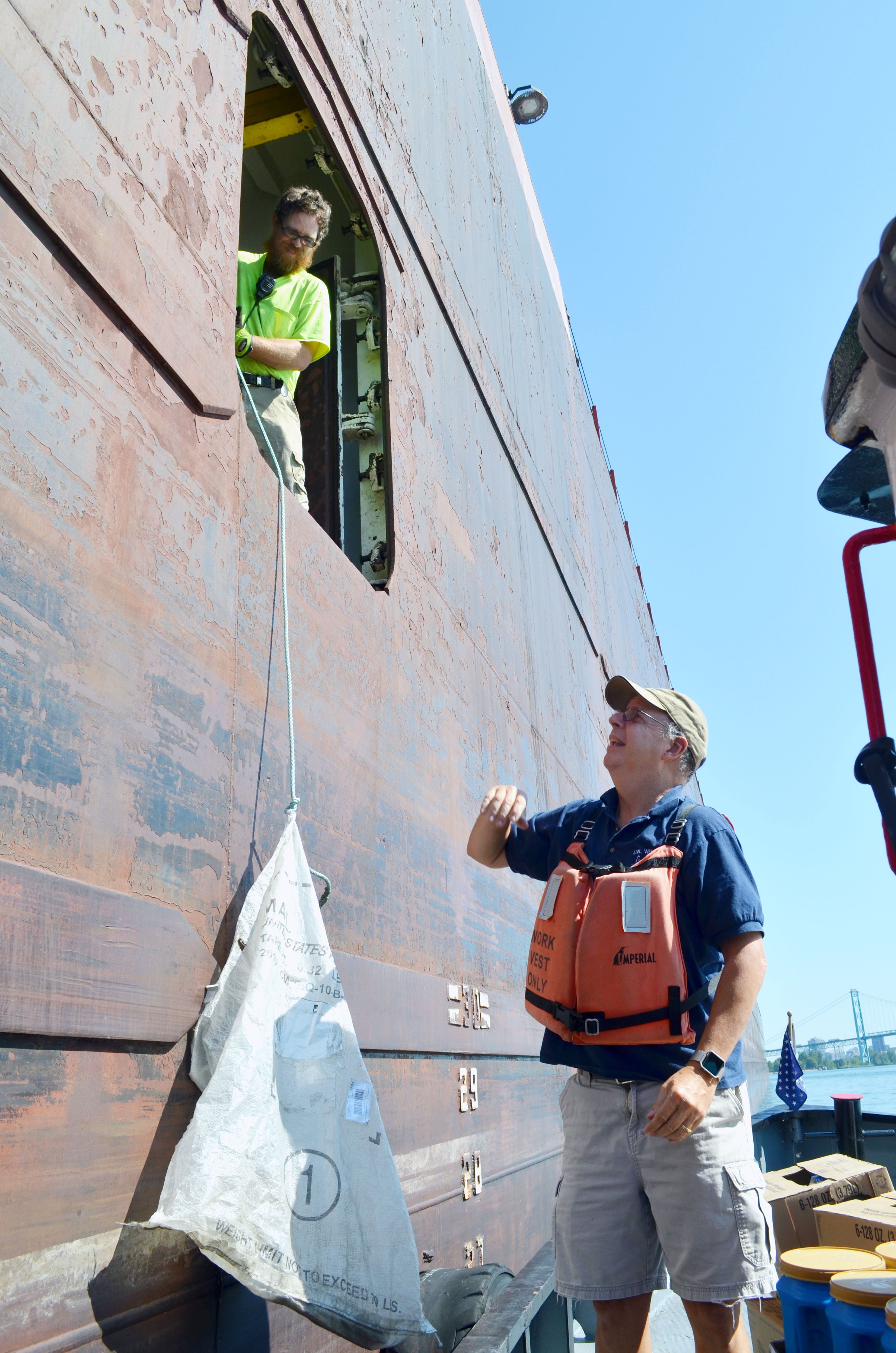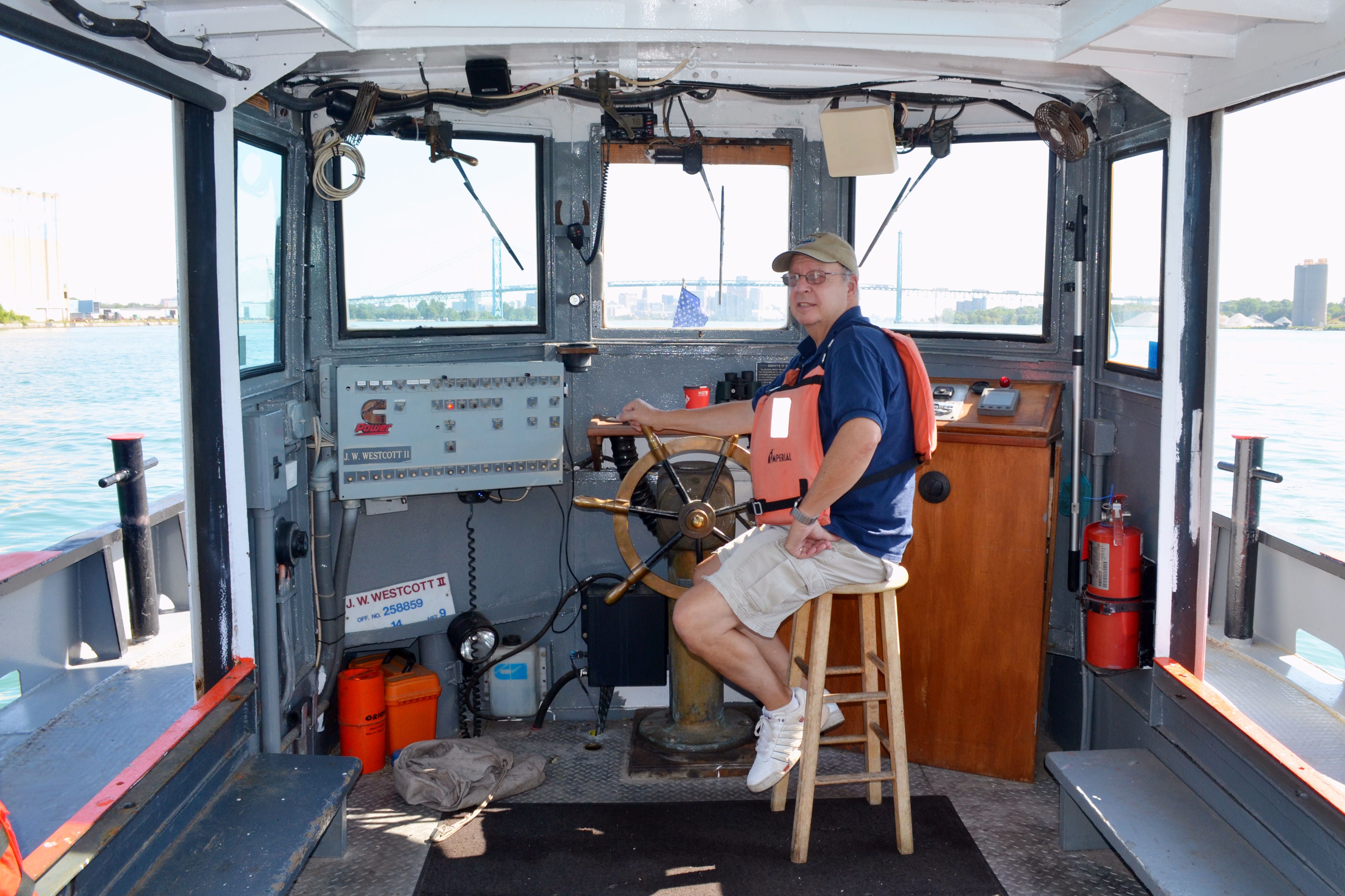It's a sunny day on the Detroit River, and the G3 Marquis, a 740-foot bulk carrier, is sailing downriver and has just passed underneath the Ambassador Bridge.
Capt. Bill Redding and Capt. Bill Griffore board the J.W. Westcott II, a comparatively diminutive 45-foot boat, and pull up alongside the G3 Marquis. While Griffore pilots the smaller boat, two heads poke over the starboard side of the larger ship, and an orange bucket is lowered down with a rope. In a process that takes about 10 seconds, Redding deposits the ship’s mail and any supplies they’ve requested in the bucket and they’re hoisted up.

A crew member in the engine room of the Indiana Harbor pulls up a mail sack from the J.W. Westcott II's Capt. Bill Redding on the Detroit River. Photo by Dustin Blitchok.
It’s a transaction Capt. Sam Buchanan, 50, the good-natured general manager of the J.W. Westcott Co., calls a “controlled collision,” and it’s been executed countless times in the company’s 143 years. J.W. Westcott is the only floating zip code in the U.S.: 48222.
While the work of one of Detroit’s oldest businesses might seem outmoded, J.W. Westcott has changed with the times. The orange bucket lowered over the side of the G3 Marquis might have once contained navigational charts, but it’s now more likely to hold a package ordered by a sailor on Amazon.com, Inc. AMZN.
Tracking Ships On Smartphones — And Paper
J.W. Westcott has had a contract with the U.S Postal Service since 1948. In the mailroom at the company’s 24th Street headquarters, the boxes are ordered alphabetically by vessel name.
The company’s slogan is “mail by the pail,” and a children’s book of the same name was published about how J.W. Westcott delivers mail to Great Lakes freighters.
The workflow for J.W. Westcott's 10 full-time and seven to eight part-time employees touches on both modern technology and analog tradition.
Marine traffic on the Detroit River, Lake Erie and Lake St. Clair is observed on computer screens using AIS tracking. Each passing commercial ship is recorded in a handwritten log as well.
While J.W. Westcott staff once had only an hour’s notice of passing ships before the advent of electronic ship tracking, Redding now has an app on his smartphone called MarineTraffic.
“I look at it before I leave the house in the morning and see what kind of day I’m going to have.”
Ships email J.W. Westcott about one day before passing through Detroit with orders for items such as groceries and toiletries, Redding said. Contact is made via marine band radio about an hour before ships connect with the J.W. Westcott II on the Detroit River.
About 18 to 22 delivers are made to ships in a 24-hour period, Redding said. “Once we begin our season, the door virtually does not lock until the end of the season.”
‘The Worst Day Of My Life’
It’s the law that international vessels — "saltwater ships" — must be piloted by those with local knowledge when passing through waterways such as the Detroit River.
On Oct. 23, 2001, the J.W. Westcott II was en route to relieve a pilot on the Sidsel Knutsen and deposit another at the Kapitonas Andzejauskas when, just before 7 a.m., tragedy struck.
After the pilot boat came alongside the Sidsel Knutsen, which was transporting 35,000 gallons of gas, it listed to port and capsized, according to an eyewitness on the tanker above who was quoted in the U.S. Coast Guard report on the accident.
Capt. Catherine Nasiatka and deckhand David Lewis drowned — the first fatalities in J.W. Westcott’s history, despite the fact that the company’s staff once rowed out into the river by hand.
The two pilots on board, David Roessllein and Allain Gindroz, survived.
The Coast Guard concluded that the J.W. Westcott II may have come alongside the tanker too far aft, near the 533-foot-long ship’s propellers.
Buchanan remembers the day as the worst of his life. “One little thing after another went wrong” in the moments leading up to the accident, he said.
“I wouldn’t wish that on anybody — to have people you work with get killed,” he said. “I hope I never have another day like that as long as I live.”
J.W. Westcott’s history is peppered with instances where the company’s staff helped avert a tragedy.
On Sept. 12, 1880, founder John Ward Westcott witnessed two young boys in a rowboat who were struck by a ferry and rescued them, according to a history of the company published in 1979. A reporter at the Westcott Co., Art Pominville, was recognized in 1908 for having saved 14 people from the river over a five-year stretch.
The tradition continued on April 17, when Buchanan’s son, Joe, was part of one such rescue. Members of the J.W. Westcott crew helped rescue a pregnant woman who was in the river, along with two Detroit cops and a medic who had jumped in to help.
When police arrived, the woman was hanging on to a tree branch by her teeth in the water, estimated at 40 to 50 degrees, according to the Detroit News.

Capt. Bill Redding in the pilothouse of the J.W. Westcott II, a mail boat that's the only floating zip code in the U.S. The boat was built by the now-defunct Paasch Marine Service in 1949. Photo by Dustin Blitchok.
Adapting To The Customer For 143 Years
On one run, Buchanan and Redding hop on the J.W. Westcott II to bring supplies to the Indiana Harbor, a 1,000-foot freighter that primarily carries iron ore pellets and coal. It’s owned by the American Steamship Co., one of the companies J.W. Westcott works with most often.
The ship is stationary, refueling at the Warner Petroleum Dock, and Redding tosses coffee and paper products to a crew member who’s standing in the freighter’s engine room.
The value of J.W. Westcott’s services are tied directly to the enormous overhead of operating a ship, Buchanan said.
“Keep in mind: When these ships are in service, there’s a meter running.”
The company predates the widespread use of the telephone, not to mention the internet. Before those technologies were adopted in the industry, part of J.W. Westcott’s business was to hand-deliver orders from shipping companies to freighters.
“We’re a small company that diversified when maybe it wasn’t cool, and we’ve always been able to adapt to customers’ needs,” Buchanan said, standing at the company’s dispatch desk.
The J.W. Westcott II and The Huron Maid, a leased pilot boat, are visible in the window behind him, tied up at the dock.
“I always tell customers that as long as we’re around, they have an office in Detroit.”
Related Links:
CBRE: Downtown Detroit Will See $5.4 Billion Investment Between Now And 2020
Project Green Light: In Detroit, Cameras — And Comcast — Are Helping Bring Crime Down
________
Main Image Credit: Capt. Sam Buchanan of the J.W. Westcott Co. stands on the bow of the company's mail boat during a delivery to the Indiana Harbor bulk carrier on the Detroit River. Photo by Dustin Blitchok.
Edge Rankings
Price Trend
© 2025 Benzinga.com. Benzinga does not provide investment advice. All rights reserved.
Trade confidently with insights and alerts from analyst ratings, free reports and breaking news that affects the stocks you care about.